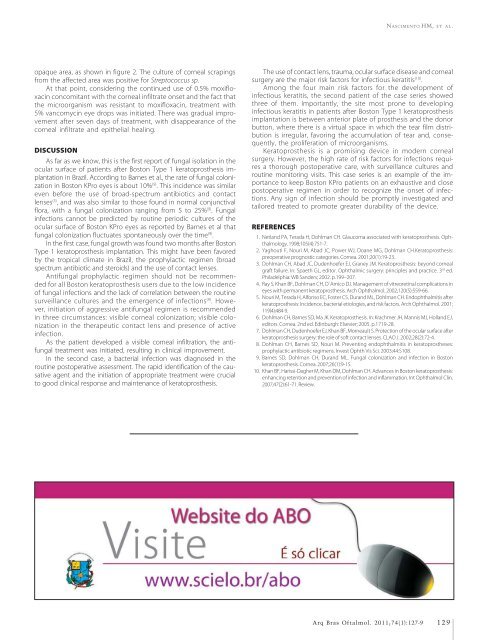a rquivos b rasileiros - Conselho Brasileiro de Oftalmologia
a rquivos b rasileiros - Conselho Brasileiro de Oftalmologia
a rquivos b rasileiros - Conselho Brasileiro de Oftalmologia
Create successful ePaper yourself
Turn your PDF publications into a flip-book with our unique Google optimized e-Paper software.
NASCIMENTO HM, ET AL.<br />
opaque area, as shown in figure 2. The culture of corneal scrapings<br />
from the affected area was positive for Streptococcus sp.<br />
At that point, consi<strong>de</strong>ring the continued use of 0.5% moxifloxacin<br />
concomitant with the corneal infiltrate onset and the fact that<br />
the microorganism was resistant to moxifloxacin, treatment with<br />
5% vancomycin eye drops was initiated. There was gradual improvement<br />
after seven days of treatment, with disappearance of the<br />
corneal infiltrate and epithelial healing.<br />
DISCUSSION<br />
As far as we know, this is the first report of fungal isolation in the<br />
ocular surface of patients after Boston Type 1 keratoprosthesis implantation<br />
in Brazil. According to Barnes et al., the rate of fungal colonization<br />
in Boston KPro eyes is about 10% (9) . This inci<strong>de</strong>nce was similar<br />
even before the use of broad-spectrum antibiotics and contact<br />
lenses (5) , and was also similar to those found in normal conjunctival<br />
flora, with a fungal colonization ranging from 5 to 25% (9) . Fungal<br />
infections cannot be predicted by routine periodic cultures of the<br />
ocular surface of Boston KPro eyes as reported by Barnes et al that<br />
fungal colonization fluctuates spontaneously over the time (9) .<br />
In the first case, fungal growth was found two months after Boston<br />
Type 1 keratoprosthesis implantation. This might have been favored<br />
by the tropical climate in Brazil, the prophylactic regimen (broad<br />
spectrum antibiotic and steroids) and the use of contact lenses.<br />
Antifungal prophylactic regimen should not be recommen<strong>de</strong>d<br />
for all Boston keratoprosthesis users due to the low inci<strong>de</strong>nce<br />
of fungal infections and the lack of correlation between the routine<br />
surveillance cultures and the emergence of infections (9) . However,<br />
initiation of aggressive antifungal regimen is recommen<strong>de</strong>d<br />
in three circumstances: visible corneal colonization; visible colonization<br />
in the therapeutic contact lens and presence of active<br />
infection.<br />
As the patient <strong>de</strong>veloped a visible corneal infiltration, the antifungal<br />
treatment was initiated, resulting in clinical improvement.<br />
In the second case, a bacterial infection was diagnosed in the<br />
routine postoperative assessment. The rapid i<strong>de</strong>ntification of the causative<br />
agent and the initiation of appropriate treatment were crucial<br />
to good clinical response and maintenance of keratoprosthesis.<br />
The use of contact lens, trauma, ocular surface disease and corneal<br />
surgery are the major risk factors for infectious keratitis (10) .<br />
Among the four main risk factors for the <strong>de</strong>velopment of<br />
infectious keratitis, the second patient of the case series showed<br />
three of them. Importantly, the site most prone to <strong>de</strong>veloping<br />
infectious keratitis in patients after Boston Type 1 keratoprosthesis<br />
implantation is between anterior plate of prosthesis and the donor<br />
button, where there is a virtual space in which the tear film distribution<br />
is irregular, favoring the accumulation of tear and, consequently,<br />
the proliferation of microorganisms.<br />
Keratoprosthesis is a promising <strong>de</strong>vice in mo<strong>de</strong>rn corneal<br />
surgery. However, the high rate of risk factors for infections requires<br />
a thorough postoperative care, with surveillance cultures and<br />
routine monitoring visits. This case series is an example of the importance<br />
to keep Boston KPro patients on an exhaustive and close<br />
postoperative regimen in or<strong>de</strong>r to recognize the onset of infections.<br />
Any sign of infection should be promptly investigated and<br />
tailored treated to promote greater durability of the <strong>de</strong>vice.<br />
REFERENCES<br />
1. Netland PA, Terada H, Dohlman CH. Glaucoma associated with keratoprosthesis. Ophthalmology.<br />
1998;105(4):751-7.<br />
2. Yaghouti F, Nouri M, Abad JC, Power WJ, Doane MG, Dohlman CH.Keratoprosthesis:<br />
preoperative prognostic categories. Cornea. 2001;20(1):19-23.<br />
3. Dohlman CH, Abad JC, Du<strong>de</strong>nhoefer EJ, Graney JM. Keratoprosthesis: beyond corneal<br />
graft failure. In: Spaeth GL, editor. Ophthalmic surgery: principles and practice. 3 rd ed.<br />
Phila<strong>de</strong>lphia: WB San<strong>de</strong>rs; 2002. p.199–207.<br />
4. Ray S, Khan BF, Dohlman CH, D´Amico DJ. Management of vitreoretinal complications in<br />
eyes with permanent keratoprosthesis. Arch Ophthalmol. 2002;120(5):559-66.<br />
5. Nouri M, Terada H, Alfonso EC, Foster CS, Durand ML, Dohlman CH. Endophthalmitis after<br />
keratoprosthesis: Inci<strong>de</strong>nce, bacterial etiologies, and risk factors. Arch Ophthalmol. 2001;<br />
119(4):484-9.<br />
6. Dohlman CH, Barnes SD, Ma JK. Keratoprosthesis. In: Krachmer JH, Mannis MJ, Holland EJ,<br />
editors. Cornea. 2nd ed. Edinburgh: Elsevier; 2005. p.1719-28.<br />
7. Dohlman CH, Du<strong>de</strong>nhoefer EJ, Khan BF, Morneault S. Protection of the ocular surface after<br />
keratoprosthesis surgery: the role of soft contact lenses. CLAO J. 2002;28(2):72-4.<br />
8. Dohlman CH, Barnes SD, Nouri M. Preventing endophthalmitis in keratoprostheses:<br />
prophylactic antibiotic regimens. Invest Ophth Vis Sci. 2003;44:S108.<br />
9. Barnes SD, Dohlman CH, Durand ML. Fungal colonization and infection in Boston<br />
keratoprosthesis. Cornea. 2007;26(1):9-15.<br />
10. Khan BF, Harissi-Dagher M, Khan DM, Dohlman CH. Advances in Boston keratoprosthesis:<br />
enhancing retention and prevention of infection and inflammation. Int Ophthalmol Clin.<br />
2007;47(2):61-71. Review.<br />
Arq Bras Oftalmol. 2011;74(1):127-9<br />
129

















